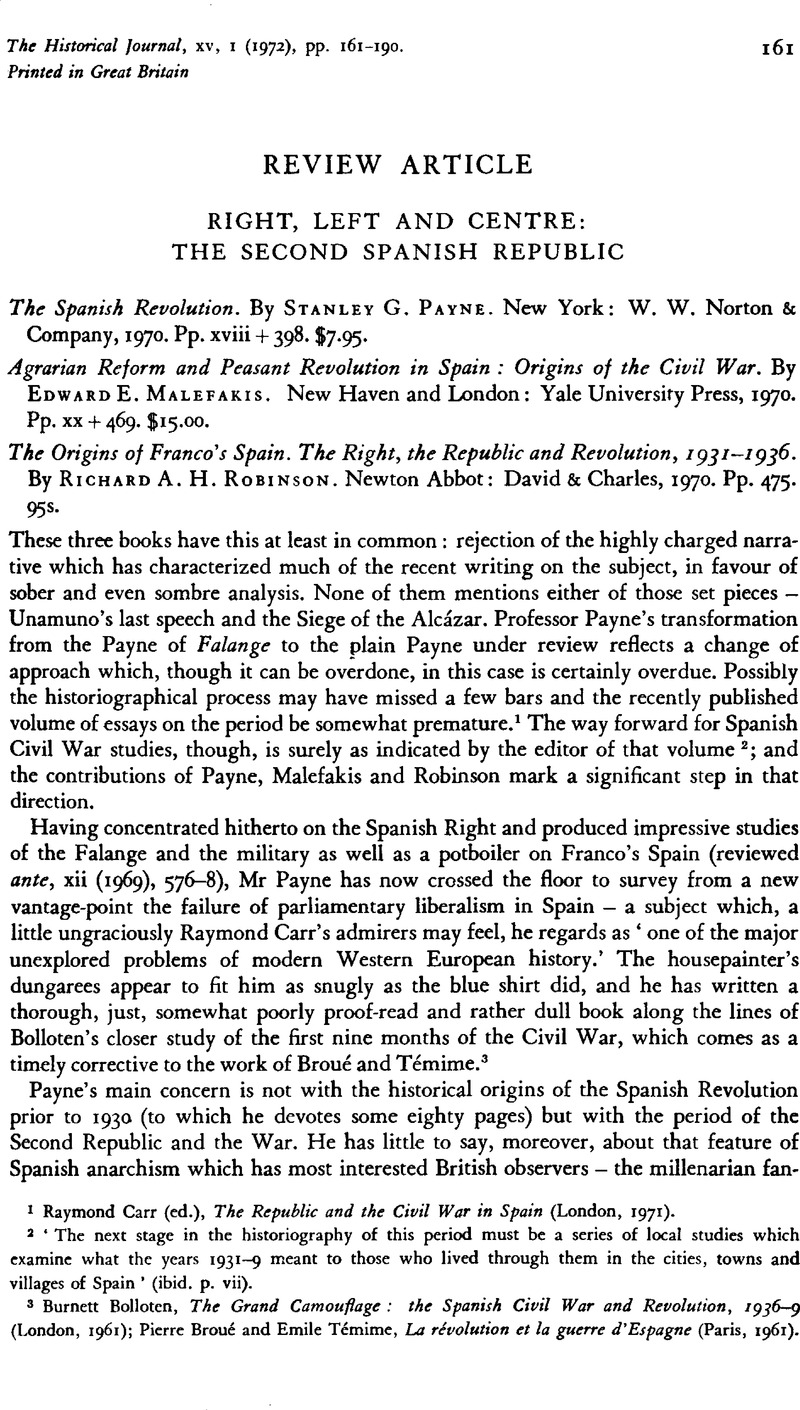No CrossRef data available.
Article contents
Right, Left and Centre: The Second Spanish Republic
Published online by Cambridge University Press: 11 February 2009
Abstract

- Type
- Review Articles
- Information
- Copyright
- Copyright © Cambridge University Press 1972
References
1 Carr, Raymond (ed.), The Republic and the Civil War in Spain (London, 1971).CrossRefGoogle Scholar
2 ‘The next stage in the historiography of this period must be a series of local studies which examine what the years 1931–9 meant to those who lived through them in the cities, towns and villages of Spain’ (ibid. p. vii).
3 Bolloten, Burnett, The Grand Camouflage: the Spanish Civil War and Revolution, 1936–9 (London, 1961)Google Scholar; Broué, Pierre and Témime, Emile, La révolution et la guerre d'Espagne (Paris, 1961).Google Scholar
4 The Thirties (London, 1940), p. 249.Google Scholar
5 Payne, pp. 236ff On this point, cf. the assessment of Thomas, Hugh in The Republic and the Civil War in Spain, p. 254.Google Scholar
6 E.g. concerning the alleged landed wealth of the Church in the South (p. 67); emigration from the South to Barcelona (p. 106); geographical explanations of the appeal of Anarchosyndicalism and Socialism (pp. 129, 133ff).
7 Pp. 197–8: ‘It would be impossible to discuss in detail the Cortes debates that followed. The discussion continued for four solid months, from 10 May to 9 Sept. 1932. Agrarian reform was debated at least briefly in 46 of the 71 sessions that were held during this period. The Diario de las Sesiones devoted almost three-tenths of its total space to reprinting the speeches presented…’
8 P. 12, n. 5: ‘In absolute terms the agricultural population of Spain has actually increased during the past 60 years. Its decline in relative terms is due exclusively to the increase in the total active population.’
9 E.g. pp. 156 concerning regional distribution of landholdings.
10 ‘It is in the history, not the geography, of Southern Spain that the true roots of the latifundio system are more likely to be found’, p. 50.
11 Vives, J. Vicens, Historia económica de Espana (5th ed., Barcelona, 1967), p. 223Google Scholar; Linehan, P. A., The Spanish Church and the Papacy in the Thirteenth Century (Cambridge, 1971), pp. 177ff.Google Scholar
12 But has ‘the Western world’ really ‘developed a singularly uniform ideal as to how this problem (namely, agrarian reform) should be solved ’? (p. 7). Does the West really hope ‘that enlightened bourgeois governments will come to power (in the underdeveloped world), ally themselves with whatever responsible trade union elements may exist, and deliver land to the peasantry ’?
13 For a more favourable estimate of the Azãa Government's achievement in the economic sphere, see Jackson, Gabriel, The Spanish Republic and the Civil War, 1931–;1939 (Princeton, 1965), pp. 78–97.Google Scholar
14 ‘Anyone who has tried to plough more than an acre with oxen will soon find himself kindly disposed to mules …’: Carr, Raymond, Spain 1808–1939 (Oxford, 1966), p. 24 n.Google Scholar
15 In his speech to the Cortes during the debate on Article 26 of the Constitution, 13 Oct. 1931. ‘Que haya en Espafia milliones de creyentes yo no os lo discuto; pero lo que da el ser religiosa de un país, de un pueblo y de una sociedad no es la suma numérica de creencias o de creyentes, sino el esfuerzo creador de su mente, el rumbo que sigue su cultura.’ M. Azaña, Una politica (1930–1932) (Madrid, 1932), p. 86.Google Scholar
16 ‘quin immo nihil prorsus vetat, quominus christifideles in civiles etiam partcs, pro stio iudicin coalescant…’: brief Laetus sane, in Acta Apostolicae Sedis, xxi (1929), 666.
17 Spain (London, 1942), p. 337.Google Scholar
18 No fue posible la paz (Barcelona, 1968)Google Scholar. Gil Robles is, of course, currently anxious to be thought of as a good Christian-Democrat; so it is necessary to compare his recollection of events now with what he was saying 30 years ago. In 1968, for example, he insisted that he had discouraged Franco, Fanjul and Goded from staging a coup in Dec. 1935; and Mr Robinson accepts this version (pp. 236, 375). In the summer of 1936, though, he told the Portuguese journalist Armando Boaventura quite the contrary – that he had urged the generals to act but that they had replied that they were not yet ready: Madrid Moscovo (Lisbon, 1937), p. 191Google Scholar. Still it must also be stressed that Gil Robles's critics rely heavily on a particular speech of Oct. 1933 for evidence of antiparliamentary leanings: thus Brenan, Gerald, The Spanish Labyrinth (Cambridge, 1943), p. 280Google Scholar; Southworth, H. R., Antifalange, trans. Martínez, José (Paris, 1967), p. 77Google Scholar. Now this speech was made during the election campaign and was clearly designed to reassure the wild men of the Right. It will be necessary to revise our view of many historical personalities, from Gregory VII to Edward Heath, if that view is to be based on a single pronouncement with no allowance made for circumstances. Anyway, Mr Robinson can supply copious evidence of a contrary sort.
19 Obras de Don Juan Donoso Cortés, ed. y Lara, J. M. Ortí, 11 (Madrid, 1904), 649.Google Scholar
20 Cf. Carr, , Spain, p. 362.Google Scholar
21 See Muntanyola, meanwhile Ramon, Vidal i Barraquer, cardenal de la pau (Barcelona, 1970).Google Scholar
22 ‘With the rebellion of 1934, the Left lost every shred of moral authority to condemn the rebellion of 1936’: Spain, p. 333. Southworth (Antifalange, pp. 78–9) charges Madariaga with failing to take the European situation into account – a fair point, but one which can be made with less justification in the case of Mr Robinson – and with treating the Spanish political scene as ‘un match de cricket, con árbitros y penalidades para las infracciones de los reglos de fairplay.’
23 Part 11, ch. Li.


